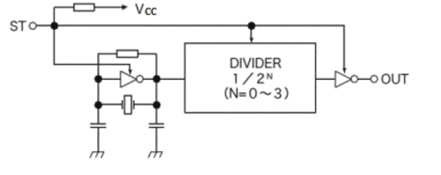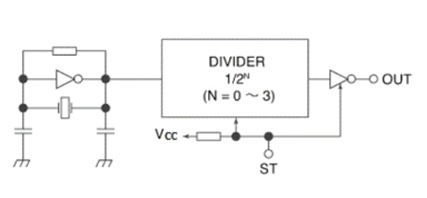Summary
Glossary
| Term | Symbol | Definition of terms (commentary) |
|---|---|---|
| Quartz crystal controlled oscillators | An electronic component containing an oscillation circuit with a crystal unit | |
| Simple packaged crystal oscillator (SPXO) | SPXO | Crystal controlled oscillator having no means of temperature control or compensation, exhibiting a frequency/temperature characteristic determined substantially by the quartz crystal resonator employed |
| Voltage controlled crystal oscillator (VCXO) | VCXO | Crystal controlled oscillator, the frequency of which can be deviated or modulated according to a specific relation, through application of a control voltage |
| Temperature compensated crystal oscillator (TCXO) | TCXO | Crystal controlled oscillator whose frequency deviation due to temperature is reduced by means of a compensation system incorporated in the device |
| Oven controlled crystal oscillator (OCXO) | OCXO | crystal controlled oscillator in which at least the piezoelectric resonator is temperature controlled |
| Nominal frequency | fnom | Frequency given by the manufacturer or the specification to identify the filter |
| Supply voltage | VCC, | DC voltage that is supplied to drive the oscillator |
| Current consumption | ICC | Value of the current that is supplied to drive the oscillator |
| Frequency tolerance | △f/f | Maximum permissible deviation of the oscillator frequency from a specified nominal value when operating under specified conditions |
| Overall frequency tolerance | △f/f | Maximum permissible deviation of the working frequency of the resonator from the nominal frequency due to a specific cause or a combination of causes |
| Storage temperature range | Tstr | Minimum and maximum temperatures as measured on the enclosure at which the device may be stored without deterioration or damage to its performance |
| Operating temperature range | Topr | Range of temperatures over which the oscillator will function, maintaining frequency and other output signal characteristics within specified tolerances |
| Stabilization time | Duration, measured from the initial application of power, required for a crystal controlled oscillator to stabilize its operation within specified limits |
|
| Frequency/voltage coefficient | Fractional change in output frequency resulting from an incremental change in supply voltage, other parameters remaining unchanged | |
| Frequency/load coefficient | Fractional change in output frequency resulting from an incremental change in electrical load impedance, other parameters remaining unchanged | |
| Long-term frequency stability | Relationship between oscillator frequency and time This is also expressed as Aging of frequency. |
|
| Short-term frequency stability | Rrandom fluctuations of the frequency of an oscillator over short periods of time | |
| Phase noise | A frequency-range measure of the short-term frequency stability of a crystal oscillator. Expressed as the power spectral density of the phase fluctuations. Also it is described phase noise. | |
| Linearity of frequency modulation deviation | Frequency-domain measure of the short-term frequency stability of an oscillator. This phase noise is normally expressed as the power spectral density of the phase fluctuations |
|
| Harmonic distortion | "Non-linear distortion characterized by the generation of undesired spectral components harmonically related to the desired signal frequency Each harmonic component is usually expressed as a power (in decibels) relative to the output power of the desired signal." |
|
| Rise time | tr | time interval required for the leading edge of a waveform to change between two defined levels |
| Decay(fall)time | tf | time interval required for the falling edge of a waveform to change between two defined levels |
| Symmetry | Ratio between the time (t1), in which the output voltage is above a specified level, and the time (t2), in which the output voltage is below the specified level, in percent of the duration of the full signal period |
|
| High level output voltage | VOH | High level side of output frequency. It is sometimes showed VOH |
| Low level output voltage | VOL | Low voltage side of output frequency.It is sometimes showed VOL. |
| Start-up time | tsu | Duration of time measured from the instant of application of power to the instant at which the crystal oscillator outputs the specified level of signal in agreement with the specified conditions |
| Phase jitter | Short-term variations of the zero crossings of the oscillator output signal from their ideal position in time | |
| Stand-by function | A function to stop oscillation by an external control voltage to the oscillator. (Oscillation of the crystal unit is stopped.) |
|
| Enable/disable function | A function to stop only the output without stopping the oscillation of the crystal unit by an external control voltage to the oscillator. |
|
| Three-state output | Output stage which may be enabled or disabled by the application of an input control signal In the disabled mode the output impedance of the gate is set to a high level permitting the application of test signals to the following stages. |
|
| Disable current | Value of the consumed current at which, by an application of external control voltage, the output is disabled while the oscillation of the crystal oscillator is maintained | |
| Stand-by current | The current consumption when the crystal oscillator has been stopped oscillating by means of a control voltage applied externally | |
| Output load condition | A load condition that can be driven by the output of an oscillator. The load as seen from the output end of the oscillator, including resistance and capacitance. Sometimes also described as load impedance. |
|
| Frequency/temperature characteristics | △f/f | Deviation of frequency from the referential frequency over the operating temperature range, while other conditions are kept constant |
| Frequency temperature slope | The amount of frequency change relative to a specified temperature range | |
| Hysteresis | The amount of frequency change at the same temperature when an oscillator is subjected to a round-trip temperature change. | |
| Output voltage | Amplitude of output waveform. |
|
| Frequency control range | Range of the variance of output frequency controlled by applying an external voltage | |
| Absolute pull range | Minimum guaranteed range of output frequency changes from the nominal frequency by an external control voltage under a specified condition or a combination of conditions | |
| Control voltage | Vcont | Input voltage applied to the frequency control terminal for controlling the output frequency |
| Frequency change polarity | Direction of the frequency change when it is raised the control voltage | |
| Frequency control sensitivity | The amount of frequency variation by defining controlled voltage. | |
| Maximum rating | The voltage, current, temperature, and power consumption that must not be exceeded for even a moment. Sometimes described as absolute maximum ratings. | |
| Input Impedance | The impedance presented by a filter to the signal source when terminated by a specified load impedance | |
| Holdover | Function to maintain the original frequency when the lock is released. |
Stabilization Time [t_stb]
![Stabilization Time [t_stb]](https://www.ndk.com/en/products/lineup/hassinki_yougo_001.jpg)
Rise Time[Tr]/Fall Time[Tf], Symmetry[SYM]
![Rise Time[Tr]/Fall Time[Tf], Symmetry[SYM]](https://www.ndk.com/en/products/lineup/hassinki_yougo_002.jpg)
Start-up Time [tsu]
![Start-up Time [tsu]](https://www.ndk.com/en/products/lineup/hassinki_yougo_003.jpg)
Stand-by Function Block Diagram

Enable/Disable Function Block Diagram

Output Voltage [Vpp]
ex) Clipped Sine
![Output Voltage [Vpp]](https://www.ndk.com/en/products/lineup/hassinki_yougo_006.jpg)
